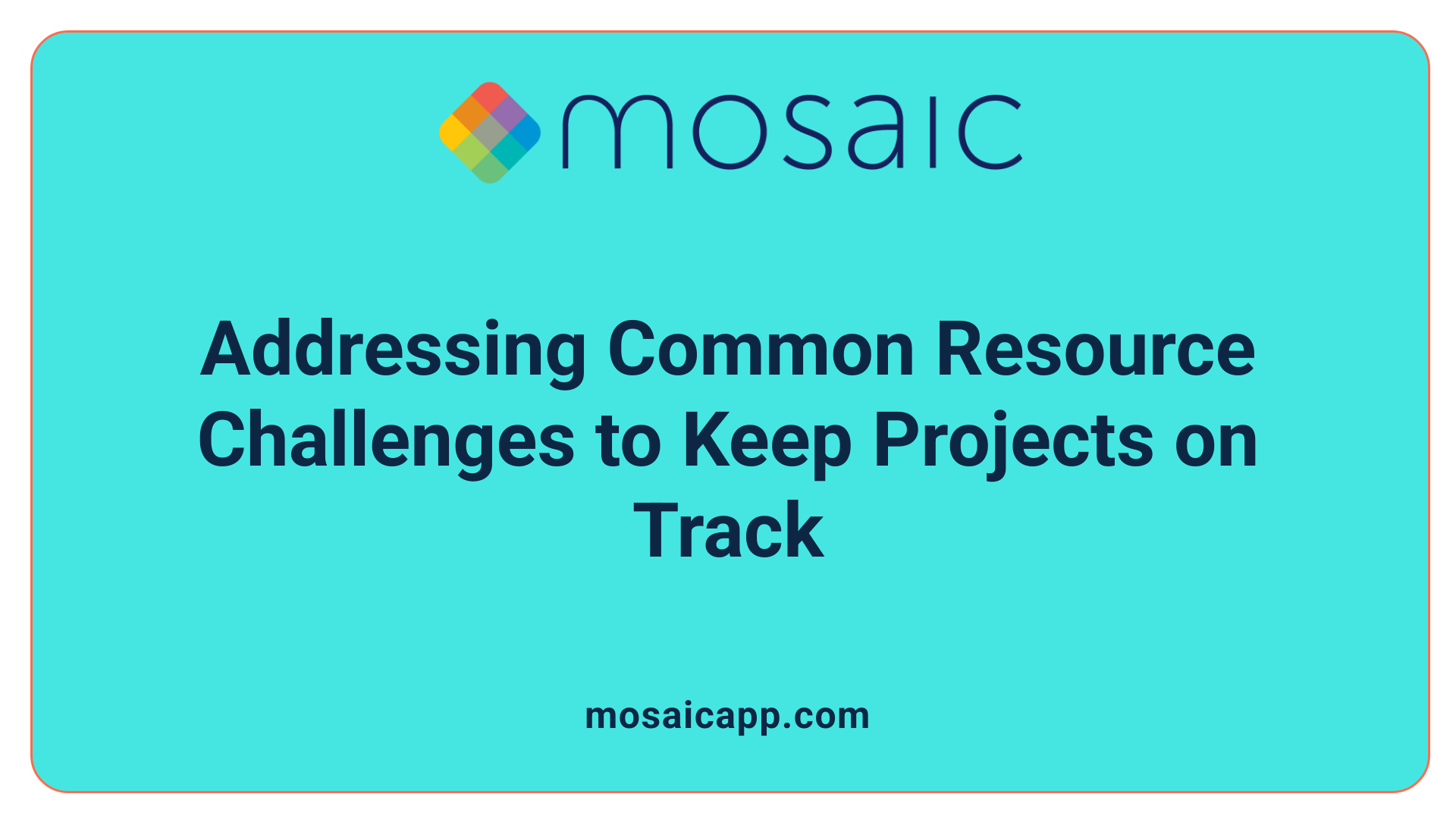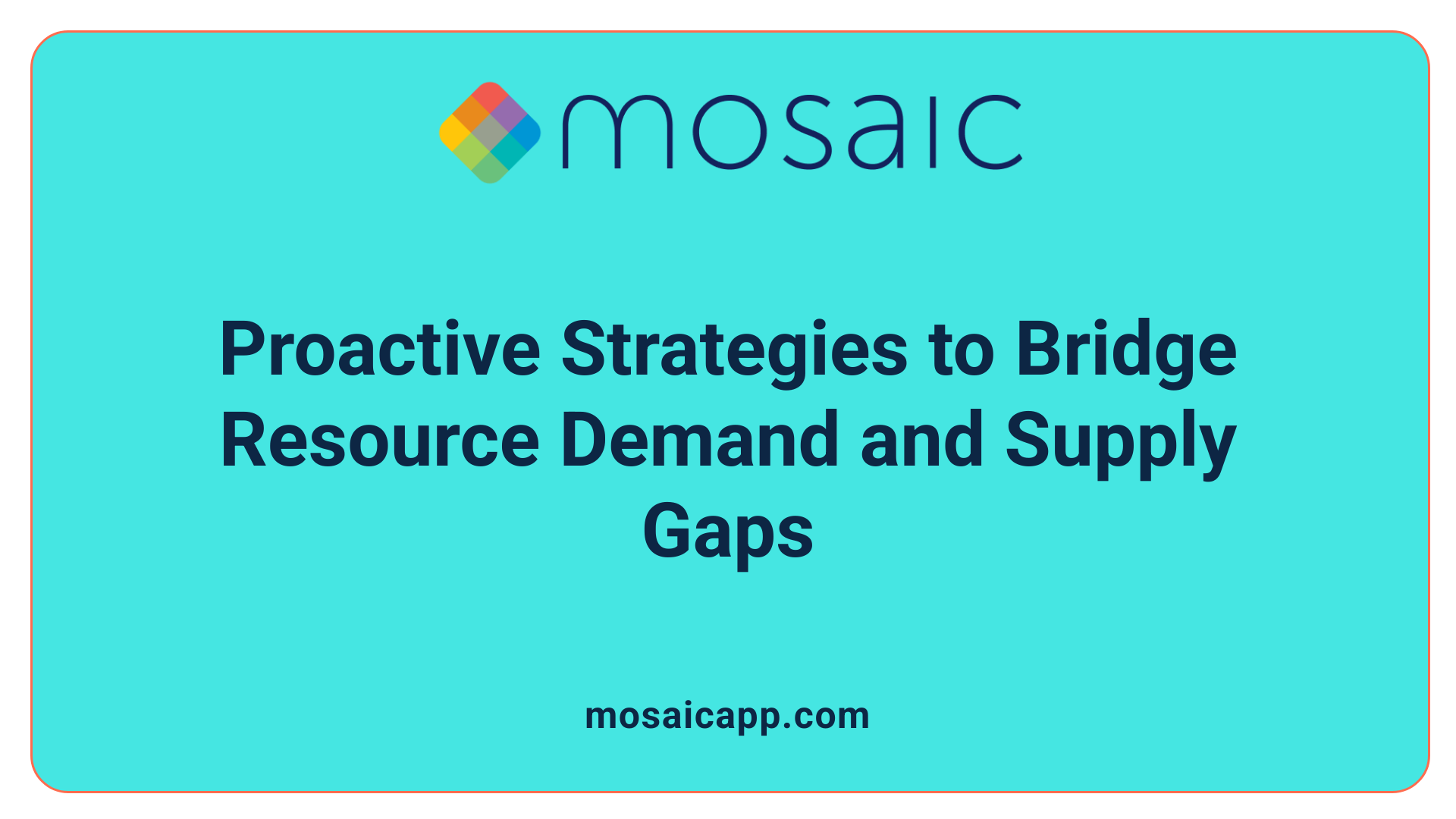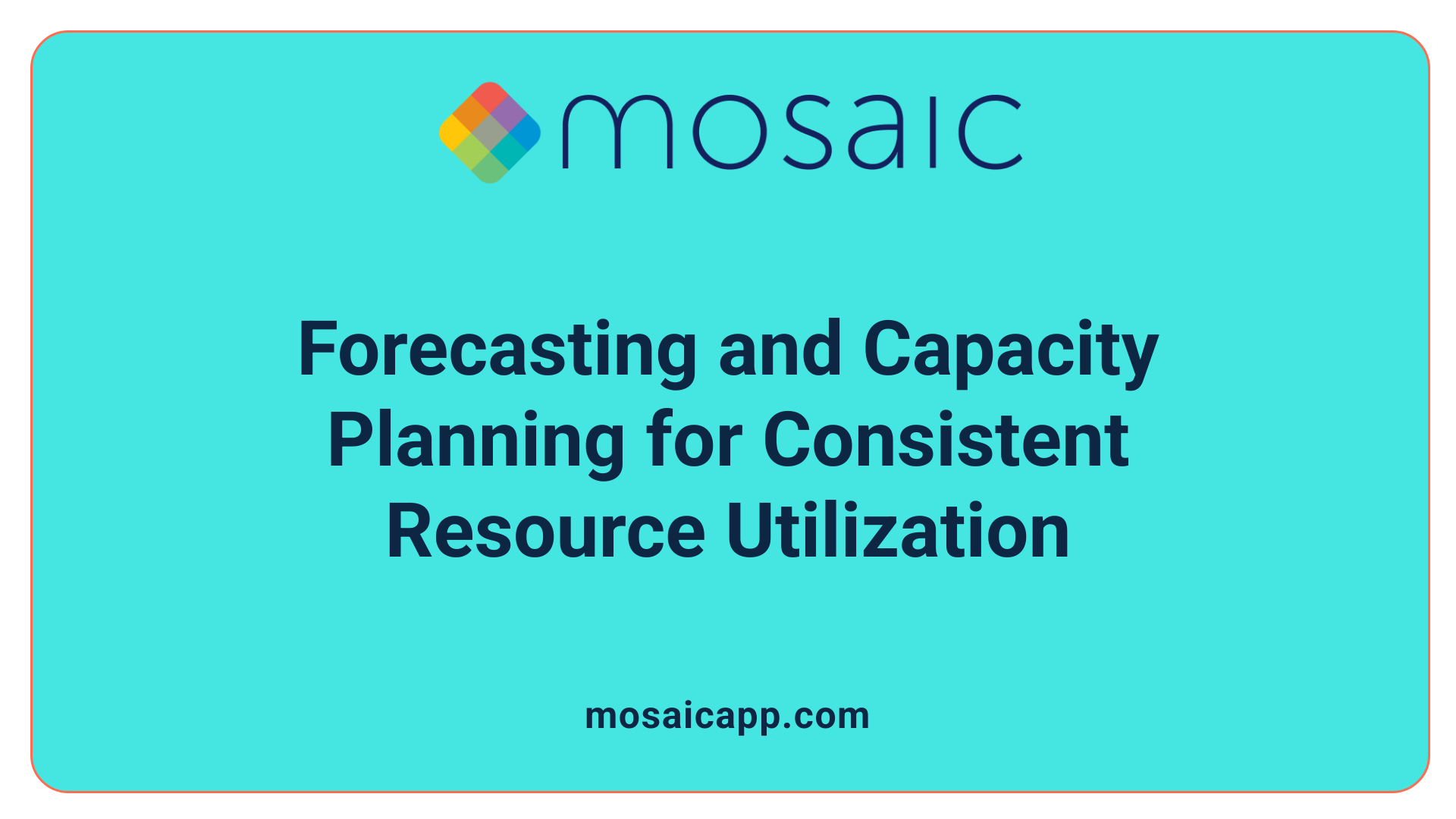Understanding the Stakes: Resource Risks in Project Management
Resource risks pose significant challenges in project management, threatening timelines, costs, and overall success. From insufficient skilled personnel to unexpected employee absences and resource conflicts, these risks can derail even the most carefully planned projects. This article explores how organizations can move from the uncertainty of bench risks to achieving predictable and optimized resource utilization through strategic planning, mitigating risks, and leveraging advanced management tools.
Defining Resource Risk: The Foundation of Effective Management

What is resource risk?
Resource risk refers to potential issues related to the availability, quality, or effective use of resources that can negatively impact project objectives. These risks arise from challenges like budget constraints, talent gaps, inaccurate estimations, and supply chain disruptions. When unmanaged, resource risks can lead to project delays, increased costs, or failure to meet quality standards.
Common types of resource-related risks
Several resource-related risks commonly affect projects. These include:
- Lack of resources: Insufficient personnel, equipment, or materials to meet project demands.
- Sub-optimal workforce utilization: Inefficient use of available staff resulting in leftover capacity or overallocation.
- Employee burnout: Excessive workload leading to fatigue and reduced productivity.
- Skill obsolescence: Workforce lacking current skills required for evolving project needs.
- Scheduling conflicts: Overlapping commitments that disrupt resource availability.
- Dependency on critical resources: Over-reliance on specific individuals or suppliers can create bottlenecks.
- Outsourcing risks: Challenges linked to external vendors including quality and timing issues.
Understanding these risks is the essential first step toward effective resource risk management in projects.
The Pillars of Resource Risk Management

How is resource risk effectively managed?
Effective resource risk management hinges on a structured process that includes several vital steps: risk identification, assessment, response planning, and ongoing monitoring.
Risk Identification involves pinpointing potential problems like resource shortages, skill gaps, or unexpected absences early in the project lifecycle.
Risk Assessment evaluates the likelihood and impact of these risks affecting project objectives, enabling prioritization.
Response Planning develops strategies to mitigate the risks, such as workforce optimization, training, or allocating backup resources.
Monitoring ensures continual oversight of resource statuses and emerging risks, allowing timely interventions.
Proactive versus reactive approaches
Proactive management focuses on early forecasting and capacity planning to anticipate resource demands and shortages before they occur. This enables projects to prepare with training, hiring, or reshuffling resources to bridge gaps.
Conversely, reactive approaches respond after risks materialize, often leading to last-minute scrambling and potential project delays.
Leveraging advanced resource management software enhances proactive efforts by providing tools such as competency matrices, utilization tracking, real-time analytics, and scenario simulations. These capabilities support early detection and mitigation of resource risks, thus protecting project success.
Adopting a proactive stance transforms resource risk from a disruptive surprise into a manageable component of project planning, ensuring smoother execution and optimized team productivity.
Common Resource Challenges: From Bench Risk to Burnout

What are examples of resource risk?
Resource risks in project management can take many forms, often disrupting project timelines and quality. Typical examples include a lack of skilled resources, which leads to delays and lower productivity. Employee burnout is another major concern, arising from overutilization and poor workload management. Unexpected absences compound these challenges by causing sudden gaps in critical roles.
Other common issues are inaccurate estimates that result in overallocation or underallocation of resources. Skill gaps emerge when workforce capabilities do not align with project demands, while scheduling conflicts can delay task completion. Projects also face risks related to dependency on critical resources and outsourcing pitfalls.
Impact on project outcomes
These resource challenges often translate into missed deadlines, budget overruns, and compromised quality. Burnout reduces employee morale and increases turnover risk, further destabilizing resource availability. A growing bench size signals inefficient resource allocation and hidden capacity costs.
Without proactive identification and mitigation of these risks, projects may suffer from reduced productivity, increased errors, and inability to meet stakeholder expectations. Therefore, addressing resource challenges thoroughly is essential to maintaining project health and ensuring successful delivery.
Mitigation Strategies: Bridging the Gap Between Demand and Supply

What mitigation strategies address resource risks?
effective resource risk management relies on several targeted strategies that specifically address common resource challenges. Demand gap management plays a crucial role by forecasting project needs accurately, helping identify resource shortages or excesses early on. This allows organizations to take proactive steps such as hiring, training, or reallocating personnel to avoid delays.
Accurate estimation is another vital strategy, which involves precise calculation of required resources to meet project demands. It prevents under or overallocation, reducing resource clashes and budget overruns while ensuring projects have the appropriate workforce and materials.
Workforce optimization focuses on deploying the right people to the right tasks, matching their skills, experience, and interests to project requirements. This maximizes productivity, reduces errors, and sustains worker morale. Additionally, techniques like resource leveling help balance workloads, preventing employee burnout and improving retention.
Training and multi-skilling enhance resource flexibility by equipping employees with diverse skills. This prepares the workforce to handle dynamic project demands, cover unexpected absences, and fill skill gaps. Targeted training programs also support succession planning and bench management, ensuring continuity and readiness.
Together, these mitigation strategies form a comprehensive approach that minimizes resource risks and strengthens project delivery outcomes.
Forecasting and Capacity Planning: The Keys to Predictable Utilization

How does forecasting help in managing resource risk?
Proper forecasting of project demand plays a crucial role in managing resource risk by identifying potential shortages or excesses early on. This advance knowledge enables project managers to take proactive steps—such as upskilling current employees, scheduling targeted training sessions, or initiating timely hiring—to ensure that resource availability aligns with project needs.
Role of forecasting
Forecasting involves predicting future resource requirements based on pipeline demand and anticipated project scopes. Accurate forecasting helps avoid surprises that can derail project timelines and budgets. It provides a foundation for planning how many people, what skills, and what equipment will be needed, which ultimately supports smoother project execution.
Capacity and workload planning
Capacity planning is the process of assessing the available workforce and other resources against forecasted demands. When combined with workload planning, it ensures that resources are not over or underutilized. Techniques such as resource leveling prevent employee burnout, maintain morale, and enhance productivity by balancing workloads effectively.
Identifying resource gaps or excesses
By comparing forecasted resource requirements against current capacity, managers can spot gaps where demand exceeds supply or excesses where resources might be idle. This allows for timely interventions such as reallocating resources, hiring contingent workers, or managing the bench effectively.
Overall, precise forecasting and rigorous capacity planning form the backbone of predictable resource utilization, helping mitigate significant project risks and ensuring consistent project success.
Optimal Resource Allocation: Aligning Skills, Experience, and Interests
How does resource allocation affect project outcomes?
Competent resource allocation is fundamental to achieving successful project outcomes. When resources—particularly human resources—are assigned based on their skills, experience, and interests, it enhances overall productivity and minimizes errors.
Importance of Competent Allocation
Allocating the right personnel to appropriate tasks ensures that project milestones are met within the required timelines. This strategic alignment also fosters employee engagement, as team members feel more motivated when their capabilities and preferences are taken into account.
Maximizing Productivity
By carefully matching resource capabilities with project demands, organizations can optimize performance on each task. This not only accelerates progress but also improves the quality of the project output, reducing the need for rework or correction.
Reducing Project Risks
Proper allocation mitigates risks such as delays, cost overruns, and burnout. Assigning tasks without considering skills or workload distribution can result in inefficiencies and missed deadlines. Correctly aligned resources help maintain balanced workloads and sustain morale, directly impacting project success.
Optimal allocation is therefore a critical component of resource risk management, ensuring projects are delivered on time, within budget, and to required quality standards.
Bench Management: Transforming Idle Resources into Assets
What is effective bench management?
Effective bench management includes foreseeing resource roll-offs and redeploying benched employees efficiently. This approach ensures continuous billability and reduces idle bench time, directly enhancing revenue for the organization. Instead of viewing bench time as a cost, effective management transforms it into an asset by aligning surplus capacity with upcoming project demands.
Challenges with bench risk
One major challenge with bench management is the increase in bench size, which can lead to high costs if benched employees remain unutilized for extended periods. Additionally, without proper planning, sudden resource shortages or project delays can arise due to mismatched skillsets or availability. Idle resources may also experience lower morale and motivation, further affecting productivity when redeployed.
Strategies for bench optimization
To optimize bench management, project managers can forecast resource roll-offs accurately and plan reassignments proactively. Maintaining a skills matrix helps in quickly identifying bench staff suitable for upcoming projects. Training and multi-skilling bench employees increase their adaptability to various project needs. Furthermore, balancing internal and contingent resources provides flexibility to address fluctuating workloads efficiently.
Enhancing billability and revenue
Optimized bench resources lead to higher utilization rates, which increases billable hours and overall revenue. Continuous monitoring using resource management software enables real-time tracking of resource availability and utilization, allowing managers to minimize bench time and maximize project contributions. Strategic redeployment and targeted upskilling ensure that bench employees add value promptly, strengthening the project's success and financial health.
Succession Planning and Backup Strategies: Mitigating Critical Role Risks
Why Is Succession Planning Important?
Succession planning plays a crucial role in resource risk management by ensuring that critical roles within a project or organization are not left vacant unexpectedly. When key personnel depart suddenly due to turnover, illness, or other reasons, projects can face delays or quality issues. By identifying and preparing potential successors ahead of time, organizations maintain continuity and reduce vulnerability to disruptions.
How Do Backup Resources Help in Risk Mitigation?
Having backup resources ready acts as a safety net that supports critical project functions in times of absence or unexpected demand. Backup strategies may include cross-training employees, developing multi-skilled teams, or maintaining a pool of bench resources who can be quickly redeployed. These approaches minimize the impact of resource shortages and ensure steady progress without compromising timelines.
Together, succession planning and backup resource strategies provide a proactive defense against risks associated with the sudden loss or unavailability of key individuals. This readiness safeguards project delivery by maintaining productivity and morale, while also protecting revenue streams through continuous billability.
Effective Practices for Backup and Succession
- Identify critical roles and possible successors early.
- Implement training and multi-skilling programs.
- Maintain resource visibility through management software.
- Forecast project demand to anticipate resource gaps.
- Align backup plans with overall project scheduling and workforce optimization.
By embedding these methods, resource risks linked to key personnel can be anticipated and managed well in advance, thus enhancing the resilience and success of projects.
Leveraging Global and Contingent Resources for Cost Effectiveness
Using Global Resources
Utilizing global resources involves tapping into talent pools across different geographic locations. This approach allows organizations to access diverse skill sets and often more cost-effective labor, increasing flexibility in resource allocation. Leveraging time zone differences can also facilitate round-the-clock project work, accelerating progress and reducing delays.
Diversifying Vendors and Contingent Workforce
Diversifying vendors and employing a contingent workforce helps mitigate risks related to supplier dependency and resource shortages. By having multiple vendors and flexible staffing options, projects avoid bottlenecks caused by unforeseen absences or supply chain disruptions. This strategic mix ensures that critical project roles remain filled without over-reliance on any single source.
Benefits for Clients and Projects
Employing a global and contingent resource strategy leads to cost savings without sacrificing quality. Projects benefit through enhanced coverage, addressing resource gaps efficiently while maintaining continuous client engagement. This approach supports 24/7 service delivery, improving client satisfaction and project outcomes.
How Can Global and Contingent Resources Reduce Project Risks?
Leveraging global, cost-effective resources helps reduce overall project costs while maintaining quality standards. It minimizes risks by providing access to a larger talent pool and enabling 24/7 client services, which collectively reduce project delays and resource shortages.
Training and Multi-Skilling: Building a Versatile Workforce
What is the role of training and multi-skilling in resource management?
Targeted training and multi-skilling play a pivotal role in effective resource management by reducing existing skill gaps within the workforce. When team members acquire multiple competencies, they gain the flexibility to take on varied roles as project demands evolve. This versatility ensures that workforce capacity aligns well with the changing needs of dynamic projects, preventing bottlenecks and resource shortages.
Addressing skill gaps through tailored training programs equips employees with the necessary capabilities to meet emerging challenges. This proactive approach helps organizations stay ahead of technology changes and market shifts, minimizing risks related to skill obsolescence.
Moreover, enhancing workforce versatility allows project managers to allocate resources more competently, balancing workloads while maintaining morale. Employees engaged in continuous learning are less likely to experience burnout because they are empowered and motivated.
By accommodating dynamic project demands, organizations can deliver projects on time and within budget while maintaining a high standard of quality. Thus, incorporating structured training and multi-skilling into resource risk management strategies is essential for resilient and agile project execution.
Technology Empowering Resource Risk Mitigation
Features of advanced resource management software
Advanced resource management software revolutionizes how organizations handle resource risks by offering comprehensive tools to enhance decision-making and planning. These platforms typically include 360-degree resource visibility, allowing managers to view utilization, availability, and skills of each resource instantly. Competency matrices help align skills with project needs, ensuring that the right person is allocated to each task.
Capacity planning features enable teams to forecast demand accurately and address potential shortages or surpluses before they impact projects. Real-time utilization reports provide ongoing insights into how effectively resources are used, helping to prevent issues like overallocation or employee burnout.
Forecasting, utilization tracking, scenario simulation
Forecasting capabilities allow organizations to predict future resource needs, facilitating proactive hiring, training, or reallocation. Utilization tracking ensures resources are optimally engaged without overburdening individuals, which maintains morale and productivity.
Scenario simulation tools enable project managers to test "what-if" situations—such as resource shortages or schedule shifts—allowing for risk-informed decision-making. This dynamic planning helps to mitigate unforeseen problems and adapt quickly to changes in project scope or resource availability.
Examples of software tools
Several software solutions stand out for their robust features to manage resource risks effectively:
| Software | Key Features | Impact on Risk Mitigation |
|---|---|---|
| SAVIOM | Competency matrices, forecasting, utilization tracking, project vacancy reports | Enhances resource alignment and anticipates shortages |
| eResource Scheduler | Capacity planning, scheduling, real-time analytics, scenario simulation | Facilitates dynamic adjustments and optimal utilization |
| Kantata | Resource scheduling, forecasting, dependency mapping | Identifies conflicts early and manages resource dependencies |
| Scoro | Workload management, real-time reporting, project tracking | Prevents overallocation and improves accountability |
| Float | Visual resource scheduling, team planning, utilization insights | Simplifies tracking of resource availability and usage |
These tools collectively help organizations to identify potential resource risks early, plan contingencies with confidence, and maintain project momentum without costly delays or employee burnout.
How do resource management software tools aid in mitigating resource risks?
Advanced software like SAVIOM and eResource Scheduler provide features such as 360-degree resource visibility, competency matrices, capacity planning, utilization reports, scenario simulations, and real-time analytics to support effective risk mitigation. These capabilities empower project managers to foresee and address resource shortages, optimize allocations, and execute contingency strategies efficiently.
Strategic Resource Planning: The Difference Between Success and Scramble
Why is strategic resource planning critical to successful project delivery?
Strategic resource planning is essential because it guarantees resources like people, money, equipment, and technology are allocated efficiently to meet project objectives. It supports timely allocation, monitoring progress, optimizing costs, and maintaining an audit trail. Without it, projects risk resource clashes, lack of accountability, and inadequate risk assessment that can lead to last-minute scrambling.
Importance of strategic resource planning
Effective resource planning distinguishes smooth project delivery from chaotic last-minute fixes. By anticipating resource needs, teams can prevent over or under-utilization. This ensures projects stay on schedule and within budget. It also supports utilization targets that help measure how much of an employee's available time is billable, which is critical for managing workforce productivity.
Avoiding common problems such as clashes and inadequate risk assessment
Resource clashes occur when multiple projects compete for the same resource. Strategic planning identifies such conflicts early and schedules accordingly to resolve them. It also builds in risk assessment to foresee potential shortages or bottlenecks. Tools like forecasting, capacity management, and resource scheduling software help spot these risks, allowing managers to create contingency plans.
Best practices for large projects
For large projects, it's vital to:
- Identify all necessary resources upfront
- Prioritize resources based on project impact
- Refer to previous projects' data to estimate needs
- Utilize project management tools for scheduling and tracking
- Estimate shortfalls well in advance
- Schedule resources appropriately to avoid conflicts and idle time
By following these steps, large projects can optimize resource use, maintain accountability, and stay on track without scrambling.
| Aspect | Purpose | Benefit |
|---|---|---|
| Resource forecasting | Predict resource needs and gaps | Proactive hiring/training and allocation |
| Utilization tracking | Monitor employee billable time | Enhances productivity and morale |
| Risk assessment | Identify potential resource clashes or shortages | Enables early mitigation strategies |
| Scheduling tools | Allocate resources to avoid conflicts | Prevents overbooking and idle time |
From Risk to Predictability: The Path Forward
Navigating the complexities of resource risk requires a comprehensive approach that encompasses foresight, skilled allocation, ongoing training, and the adoption of powerful management tools. By systematically identifying and mitigating potential risks — from bench management challenges to employee burnout and skill gaps — organizations can transform unpredictable resource utilization into a streamlined, efficient process. With diligent forecasting, strategic planning, and technology integration, businesses move from reactive firefighting to proactive resource stewardship, ensuring project success, optimized billability, and sustainable growth.

